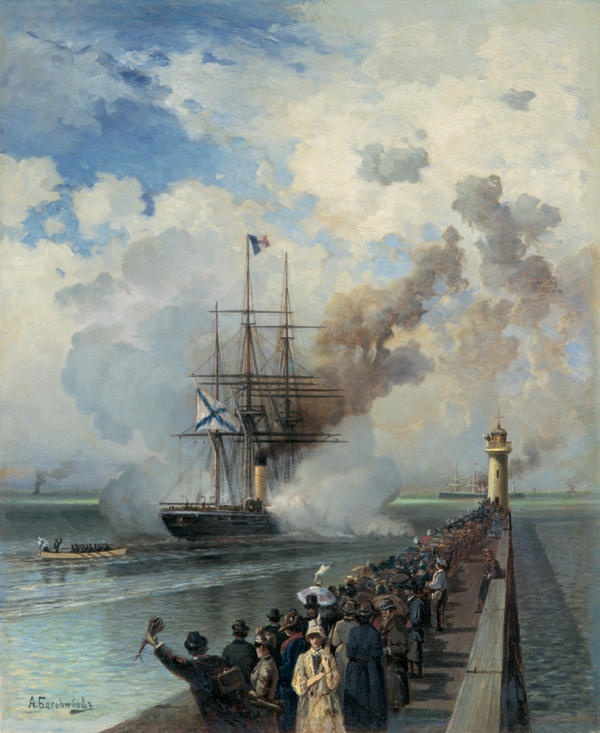Frigate Razboinik leaving Le Havre Port and saluting the French Navy was a commissioned version of one of the works by painter Alexei Bogolyubov. The painting was done by Russian marine painter Leonid Blinov at the turn of the 20th century.
For a long time, the painting was believed to have been done by Alexei Bogolyubov himself, and only in 2015 it was finally attributed to Leonid Blinov. Blinov had put his signature on the canvas, but one of the later owners must have painted over it and replaced with that of Bogolyubov. Blinov’s signature was rediscovered under x-ray during the appraisal.
The painting illustrates a moment in the history of the Russian Navy. In 1887, the Russian screw clipper Razboinik of the frigate class accompanied the imperial yacht. At the French port of La Havre she was reinforced and set out on a trip round the world.
In the foreground is the embankment that stretches away to the skyline and the lighthouse. It is full of the milling crowds seeing off the frigate, all well-dressed men and women. Many are carrying walking sticks or umbrellas. Facing the viewers is a lady in a light elegant outdoor costume. Her bodice looks like a man’s jacket, reflecting a common trend of the time when the lady’s costume was adopting elements of men’s clothing.
At the centre of Blinov’s painting is the frigate leaving Le Havre. Her starboard side can hardly be seen for the smoke of the saluting guns, and the frigate is followed by a rowing boat with a group of sailors. The smoke from Razboinik’s cannons dissolving in the grey blue clouds, the abrupt angle of the crowds disappearing in the distance, all these details demonstrate the fine interplay of light and shadow and the masterful rendition of the light and air and the depth of the space.
Leonid Blinov is one of the best Russian marine painters of the second half of the 19th century. A graduate of the Imperial Academy of Art, he served as a painter at the Navy Ministry. Blinov took part in sea voyages by Russian navy and merchant ships and participated in the expedition in the North Arctic Ocean. Today Blinov’s paintings adorn museums in Russia and elsewhere, but the largest collection of the works by the master is in the Central Museum of the Navy.
For a long time, the painting was believed to have been done by Alexei Bogolyubov himself, and only in 2015 it was finally attributed to Leonid Blinov. Blinov had put his signature on the canvas, but one of the later owners must have painted over it and replaced with that of Bogolyubov. Blinov’s signature was rediscovered under x-ray during the appraisal.
The painting illustrates a moment in the history of the Russian Navy. In 1887, the Russian screw clipper Razboinik of the frigate class accompanied the imperial yacht. At the French port of La Havre she was reinforced and set out on a trip round the world.
In the foreground is the embankment that stretches away to the skyline and the lighthouse. It is full of the milling crowds seeing off the frigate, all well-dressed men and women. Many are carrying walking sticks or umbrellas. Facing the viewers is a lady in a light elegant outdoor costume. Her bodice looks like a man’s jacket, reflecting a common trend of the time when the lady’s costume was adopting elements of men’s clothing.
At the centre of Blinov’s painting is the frigate leaving Le Havre. Her starboard side can hardly be seen for the smoke of the saluting guns, and the frigate is followed by a rowing boat with a group of sailors. The smoke from Razboinik’s cannons dissolving in the grey blue clouds, the abrupt angle of the crowds disappearing in the distance, all these details demonstrate the fine interplay of light and shadow and the masterful rendition of the light and air and the depth of the space.
Leonid Blinov is one of the best Russian marine painters of the second half of the 19th century. A graduate of the Imperial Academy of Art, he served as a painter at the Navy Ministry. Blinov took part in sea voyages by Russian navy and merchant ships and participated in the expedition in the North Arctic Ocean. Today Blinov’s paintings adorn museums in Russia and elsewhere, but the largest collection of the works by the master is in the Central Museum of the Navy.



